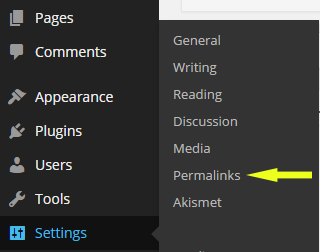Updated: Apr 28, 2017
Here’s a common scenario:
You want to optimize your website for search, and you aren’t quite sure where to start. You read a few articles and after searching around for a bit, you end up finding the perfect WordPress plugin to handle your new SEO (Search Engine Optimization) strategy.
Perfect scenario, right?
Unfortunately, it’s sometimes not that simple. It’s true WordPress can be a simple, user-friendly CMS, but your SEO strategy will take more work than simply hitting publish on your latest page or blog post.
Here are some of the common SEO issues associated with WordPress – and how to solve them.
1. Optimize Page Titles & Descriptions
Page titles and meta descriptions are arguably two of the most important aspects when it comes to your SEO strategy.
These attributes are important for two major reasons:
- Search Engines. Page titles factor heavily into whether your website will be shown in SERP (Search Engine Results Page) and whether users will click through. Keyword-rich page titles help search engines determine what your page is about and whether it’s relevant to a user’s search query.
- User activity. Even after serving your site as a result, it’s important to have a well-crafted page title and meta description to help guide users to your site. Relevant and informative page titles and meta descriptions help influence users to click through to your site.
Once you determine what keywords you’d like to optimize for, there are several user-friendly WordPress plugins to help users easily create optimized page titles and meta descriptions, most notably WordPress SEO.
2. Fix Duplicate Blog Content
Blogging is a great way to create content for your site, but there are numerous mistakes you can make as you publish new content.
One of the more common mistakes we’ve seen revolves around one of the cardinal sins of SEO: duplicate content. Duplicate content is extremely harmful to your site; not only does it devalue your content, but most importantly, this could be viewed as “spammy” and can negatively impact your rankings.
But you may be asking yourself: if I’m only publishing a post once, how can this cause duplicate content? The most common cause: posting to multiple categories. If the blog category is included in the post URL, there’s a good chance it’s creating duplicate content on your site. Since the post exists in multiple categories, the content also exists in multiple URLs.
If you must keep posts under multiple categories, you have several options. One option is to completely remove the category from the URL structure of your blog posts.
To change the link structure of your blog posts, you begin by visiting Permalinks in the Settings section of your WordPress dashboard:
You can then select the URL structure of your blog posts. A helpful hint: these changes will be immediately applied to all blog posts, including ones you’ve already published.
Alternatively, you can choose to canonicalize to a single URL. This essentially tells search engines you recognize the content exists on multiple URLs, but the canonicalized URL is the original piece of content and all authority should point to this URL.
**Important Note: if you choose to update or change the URL structure of any posts (or pages), it’s incredibly important to put in 301 redirects so you don’t lose visitor traffic to your site. Otherwise, users will be directed to the old (and now non-existent) URL.
3. De-index Tag & Archive Pages
This next mistake isn’t so much of a technical mistake as it is something you’d likely want to avoid.
In an effort to help organize your blog content, you’ve likely inserted relevant tags along the way. As a result, your blog will generate tag pages to help visitors browse your blog topics by tags. This can certainly help users navigate your blog, it could have an impact on SERP. Although search engines may find these pages to be relevant to search queries, tag pages aren’t ideal for new visitors coming to your site.
Another byproduct of your blog are archive pages. These pages are automatically generated, and depending on the size of your blog, can add numerous pages to your site. These pages might improve user navigation in your blog, but it usually creates several archive pages at the root domain.
Search engines tend to find pages easier the closer they are to the root, meaning they’re also at a higher level. With numerous archive pages at the root, Google and other search engines could see your archive pages as the same level of importance as your optimized landing page – simply because they’re both located at the root domain.
Inserting noindex tags or disallowing these pages in the robot.txt file are both effective solutions to allow these pages to exist without affecting search results. Noindex tags are very straightforward – they tell search engines not to index these pages for search results. Your robot.txt works similarly, but rather than simply tell search engines to not index, you can prevent search engines from crawling these pages altogether.
4. Optimize Site Images
Depending on the nature of your site, it’s possible that images are an essential part of your website. If images are a large part of your site (and even if they’re not), it’s important to make sure you’re optimizing your images for search.
Search engines do a great job in identifying your website’s content, but it’s not as strong at identifying images. Inserting descriptive alt texts will help search engines identify the content of your images and as a result, help your site appear in more relevant searches.
Another factor to consider in regard to your site images is load time. Google has used site speed as a ranking factor for several years, and images can have an impact on your overall site speed.
Try to avoid using large image files when possible; many sites mistakenly insert large images and simply resize them on the page rather than uploading a smaller image file. Although the image appears smaller on the site, visitors still must download each image at its original size which negatively influences your site speed.
5. Optimize for Mobile Traffic
A mobile-friendly site is important for all websites, especially after Google recently rolled out changes for mobile search to emphasize pages that are mobile-friendly and penalize those that aren’t seen as mobile-friendly.
This change could have a big impact on your site traffic, especially if the majority of your traffic comes from mobile users. You can determine your mobile traffic through the Audience section in Google Analytics.
This section of Google Analytics will break down your traffic into three categories: desktop, mobile and tablet. If your site has a high volume of mobile users (tablet and mobile) and your site’s pages aren’t recognized as being mobile-friendly, your site traffic could take a significant hit.
It’s important to note that this change applies only to mobile searches. If users are searching on desktop (or on their laptop), mobile-friendliness does not factor into search results.
There are several ways to identify whether your site is mobile friendly. Google will identify mobile-friendly sites in mobile search results, so a quick search for your site should provide you with this information.
Additionally, Google released a Mobile-Friendly Test tool that will analyze whether an analyze mobile-friendliness for individual URLs while also provide feedback for sites that aren’t seen as mobile-friendly.
6. Don’t over-optimize
Even with SEO, the old adage rings true: quality over quantity.
One of the best SEO strategies is often one of the most overlooked: creating quality content. Search engines want to share the best and most relevant sites, and your site should reflect this as well. Your SEO strategy should never rely on the number of times your keyword appears on your site – quality content should always be your number one priority.











